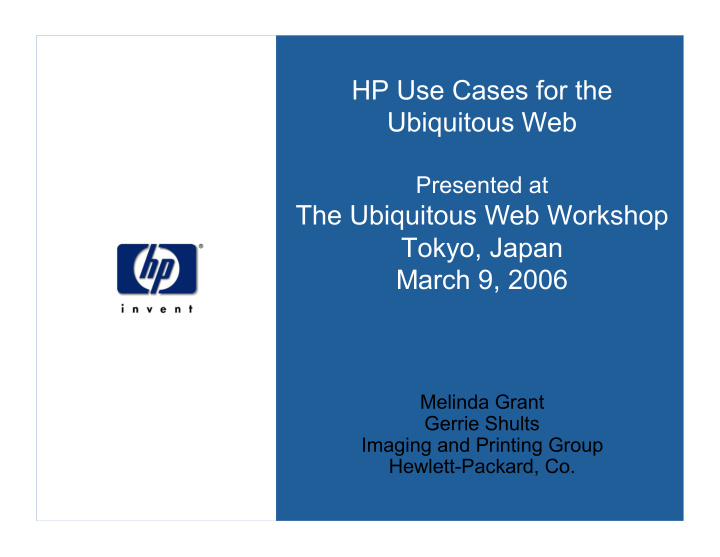



HP Use Cases for the Ubiquitous Web Presented at The Ubiquitous Web Workshop Tokyo, Japan March 9, 2006 Melinda Grant Gerrie Shults Imaging and Printing Group Hewlett-Packard, Co.
Introduction • The Web’s Problem Today – It enables long-distance, complex path, device-to-device interactions – But, actual implementations are too often complex and/or proprietary • The Need – Facilitate these interactions with ubiquitous open standards • HP proposes a Use Case-based approach to the solution – Following are some use cases HP would like to facilitate – All are implementable today. – Some already have proprietary or domain-specific implementations. • So, what’s missing? – Solutions using vendor-independent, device-independent, context-independent, open standards March 9, 2006 page 2
Use Cases March 9, 2006 page 3
Use Case 1: Photo Archiving (1) User Actions • Janine has a digital camera that is pre-configured to automatically: – Recognize public Wi-Fi hotspots, then – Archive all unarchived photos to her home server • At a hotspot the camera performs the following: – It ”securely discovers” her home archive server – It transmits new photos for archiving – It receives notification of success or failure for each individual photo – It marks successfully archived photos – It informs Janine of the results March 9, 2006 page 4
Use Case 1: Photo Archiving (2) Standard Technologies Required • Secure “discovery” of home server. This includes: – Secure transmission of all information that identifies Janine’s home and any of its devices – Secure access to Janine’s home devices through her firewall • Device-to-device protocol supporting the archive process and returned status. March 9, 2006 page 5
Use Case 2: Photo Sharing (1) User Actions • Frank and his family are visiting his parents • He takes a great photo of his kids with their grandparents using his Wi-Fi camera. His parents want a copy. • Frank presses the camera’s ‘Print and Store’ button to immediately print one 5"x7" and two wallet-size photos. • The camera finds their Wi-Fi networked printer and sends the photo. • The printer also transparently uploads a copy of the image to the default image archive server, which is located on his parents’ home computer. • This reaffirms his parents’ belief that their son is brilliant. March 9, 2006 page 6
Use Case 2: Photo Sharing (2) Standard Technologies Required • Discovery protocol to find the locally-connected printer and learn its capabilities • Standard print protocol • Standard archive protocol with transparent proxying March 9, 2006 page 7
Use Case 3: Enterprise Print (1) User Actions • Marie is visiting a major client. • To close a deal, she needs ten printed copies of the contract Statement of Work immediately. – Yes, it’s the client’s requirement, not Marie’s. – The client believes in the paperless office. Their procedures just haven’t caught up! • Marie tries to print downstairs at the client’s office – Their fast, collating, stapling, multi-copy printer is busy printing a large, higher priority job. – The printer will not be able to fulfill her request in time. • Her laptop print manager discovers that the Kinko’s across the steet can print the job on time. – She re-routes the job to Kinko’s – Before re-routing, she extends the job description with a request to have the output delivered to the client’s front desk. March 9, 2006 page 8
Use Case 3: Enterprise Print (2) Standard Technologies Required • Discovery protocol to find the printers, their capabilities and availability . • Adaptable UI on the client according to printer capabilities and availability. • Standard print protocol, including routing information, such as the delivery from Kinko’s. March 9, 2006 page 9
HP's Primary Solution Interests • Scalable Protocols – Use (or create) protocols that scale from a two sub-net home to the enterprise and the global web. – One Discovery Protocol – One Context Awareness model – One Device Capabilities model • Remote UI – Include the ability to present the user interface for one device on another • Learn from existing work on device coordination – Such as UPnP and others – Leverage where possible March 9, 2006 page 10
HP Position Summary • The solution domain is large, broad and complex • W3C is uniquely positioned to address the domain in its entirety • Many essential elements have already been standardized in various forms – Some done by the W3C and some elsewhere – This work should be leveraged where meaningful • Much work remains • It MUST all integrate seamlessly. This will take time. March 9, 2006 page 11
Background Slides March 9, 2006 page 12
Keys for Success • From the beginning, ensure that usability, accessibility, and mobility are built in. • Base the requirements and scope on Use Cases. – Understand the questions first. – Tailor the technical solution to answer the questions. – Don’t create a technical solution and then try to decide what problems it solves. March 9, 2006 page 13
Keys for Success • Treat content, communication, and services with a unified model. • Minimize implementation and communication costs. – Avoid overly-encumbered components. • Use and leverage existing technologies, where they make sense. • Use a staged approach – Identify a core set of Stage 1 solutions. – Establish a timeline for first and subsequent stages. – Publish individual components as they are mature. • This space is huge • We can't do it all at once March 9, 2006 page 14
Recommend
More recommend